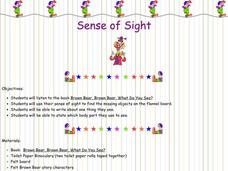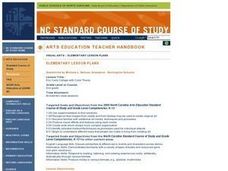Pennsylvania Department of Education
Speaking Skills
Students listen to The Hungry Caterpillar by Eric Carle and use a teacher created puppet for a listening activity. In this Hungry Caterpillar lesson, students recall the order of events in the story with the puppet and cards of the...
Curated OER
Literacy: Slowly, Slowly, Slowly Said the Sloth
Students explore language arts by analyzing a children's book in class. In this vocabulary instructional activity, students read the book Slowly, Slowly, Slowly... by Eric Carle. Students identify the characters, setting and plot of the...
Curated OER
Picture Clues and Repeated Text
Kids read The Grouchy Ladybug and predict what the outcome will be based on picture clues and repeated text. Next, they draw their predictions. A great way to use both prediction and context clue skills in your kindergarten class.
Curated OER
The Dance of the Butterfly
Students explore butterfly life cycles and movement. In this integrated fine arts and biology life cycle instructional activity, students listen to the book The Very Hungry Caterpillar by Eric Carle and identify the related life...
Curated OER
The Very Busy Spider
Students determine the best habitat for spiders. For this spider lesson, students listen to a reading of Eric Carle's, The Very Busy Spider. They discuss the spider's habitat before visiting the schoolyard to look for spiders in their...
Curated OER
Sense of Sight
Students examine the sense of sight. In this human biology activity, students read the book Brown Bear, Brown Bear, What Do You See? and discuss all of the animals seen in the story. Students use binoculars and take several digital...
Curated OER
Very Hungry Caterpillar Play-Doh
Students explore the concept of retelling a story. In this retelling lesson, students use Play-Doh to create models of the objects in Eric Carle's The Very Hungry Caterpillar. Students use these models to to retell the...
Curated OER
Learn Classmates' Names
Learners create a classroom book of names and photos. In this icebreaker lesson plan, students read the book Brown Bear, Brown Bear What Do You See and create a classroom book with the same pattern using classmates' names and photographs.
Curated OER
Hear No Evil
Students explore the function of the ears. In this sense of hearing instructional activity, students read the book Polar Bear, Polar Bear What Do You Hear and discuss the things the Polar Bear heard. Students construct simple musical...
Curated OER
Plan, Do, Review...What's Bugging You?
Students explore insects through literacy, In this literacy instructional activity, students discover the characteristics of ladybugs and gain information from the text, "The Grouchy Ladybug". Students go on a "bug hunt".
Curated OER
Brown Bear, Brown Bear What Do You See?
In these literature worksheets, students will construct a book based on the popular story "Brown Bear, Brown Bear What Do You See?" Students will color each animal according to its descriptive color in the story.
Curated OER
Brown Bear, Brown Bear
Students complete a variety of activities related to the book "Brown Bear, Brown Bear." They role-play the animals from the story, read about the book's author Bill Martin, Jr. on his website, discuss the rhythm of the story, and create...
University of Virginia
The Very Hungry Caterpillar
Students engage in a activity that is concerned with the skill of reading comprehension while reading "The Very Hungry Caterpillar" as a class. They read the story while identifying the different types of food with the help of food cards.
Curated OER
Eric Carle Collage with Color Theory
Second graders analyze color theory and collage techniques through the creation of collages in the style of artist/author Eric Carle. Color experiments and may hands-on section allow this lesson to be very informative and fun for the...
Alabama Learning Exchange
The Grouchy Ladybug
Students listen to the book, "The Grouchy Ladybug" by Eric Carle and sequence the events in the story. Using a graph, they draw and color the animals that the ladybug meets next to the corresponding time from the story, and conduct...
Curated OER
1st Grade - Act. 22: Retelling the Tiny Seed
First graders write sentences and illustrate ways seeds travel.
Curated OER
The Very Hungry Caterpillar - Collage Technique
First graders listen to the story The Hungry Caterpillar, then sequentially organize their own re-writing and re-creating of the story. They construct illustrations for their book using the collage technique Eric Carle used in his...
Curated OER
Bodaciously Beautiful Butterflies Take Flight
Students complete study on butterflies using real caterpillars, keep individual daily journals of observations, and complete timeline for their caterpillar/butterfly.
Curated OER
Eric Carle Collage
Students gain appreciation for the work of Eric Carle. They speculate about a work of art, what materials, techniques and skills were used. They study Carle's work to determine how he did it and explore various water color techniques.
Curated OER
The Art of Illustrator Eric Carle
First graders use two-dimensional and three-dimensional media and techniques to communicate ideas, experiences, and stories in works of art. They use media and tools in a safe and responsible manner
Curated OER
Brown Bear Animals
Students listen to the book Brown Bear Brown Bear What Do you See. They use a variety of art mediums to re-create large animal shapes representing the animals from the book, Brown Bear Brown Bear What Do You See.
Curated OER
Reading Comprehension: The Very Hungry Caterpillar
In this reading comprehension worksheet, students draw a picture, make words, and respond to short answer questions about The Very Hungry Caterpillar.
Curated OER
How to Make an Edible Brown Bear
Learners follow directions on how to make an edible brown bear. In this following directions lesson plan, students make their bear out of bagels, peanut butter, crackers, and more.
Free Reading
A House for Hermit Crab
Young scholars are read A House for Hermit Crab, by Eric Carle. For this vocabulary focused lesson, students discover the meaning of at least three new words. They discuss the new vocabulary, as a class, before and after the story is...

























